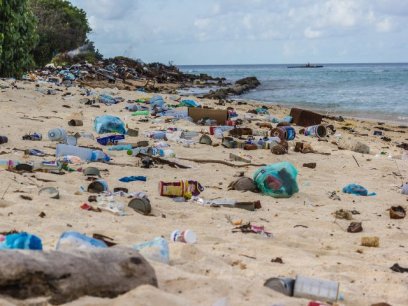
At NEEF, we believe that education, conservation, and health are important gateways for increasing people’s understanding of how the environment impacts their lives. Test your knowledge on some of the topics we’ve covered over the years by taking our interactive eco-literate quiz below. Expand the questions to see how well you know a broad range of environmental topics!
True or False: By 2050, scientists estimate that the amount of plastic in the ocean will weigh more than all the fish.
True. According to the US Fish and Wildlife Service, refuse (including plastic bags, cigarette lighters, and bottles) that we throw away on land accounts for most of the debris in our oceans. How is this possible? Because rivers and storm drains carry our discards out to sea. In fact, researchers at Columbia University’s Earth Institute estimate that eight million metric tons of plastic waste enter the oceans each year—and we can’t keep up with removal efforts. Find out how to reduce your use of plastics.
A typical city block generates more than _____ times as much rainwater runoff as a forested area of the same size.
- Two
- Five
- Eight
- Ten
B: Five. This is because rooftops and pavement don’t allow water to soak into the ground like forests, wetlands, and grasslands do. Instead, rainwater runs off pavement into the nearest storm drain, where it’s transported to local streams, rivers, and eventually the ocean. On its way to the storm drain, rainwater picks up pollutants like oil, antifreeze, pet waste, fertilizers, and pesticides. In most places, storm water does not get treated, so all of those pollutants end up in local waters. To protect water quality where you live, follow the tips from this infographic.
Common indoor asthma triggers include which of the following?
- Mold
- Dust mites
- Secondhand smoke
- Pet hair
- All of the above
E: All of the above. A changing climate will make common indoor air pollutants more widespread and more severe through increased extreme weather events and home weatherization. An increase in extreme temperatures and precipitation can lead to increased humidity and mold growth indoors, and more frequent droughts and wildfires can result in exposure to more smoke, dust, VOCs, CO, and NO2. Weatherizing homes by sealing leaks and adding insulation helps to save energy and money, but it also reduces ventilation that removes indoor air pollutants. Learn more about the steps you can take to maintain healthy indoor air quality.
True or False: US forests absorb and store about 16% of all carbon dioxide emissions associated with fossil fuel burning in the US each year.
True. Forests and trees provide many benefits and services to society, including clean water, recreation opportunities, wildlife habitat, carbon storage, watershed protection, flood control, erosion reduction, and improved human health.
Community trees help to reduce air and water pollution, improve physical and mental health, strengthen social connections, alter heating and cooling costs, and are associated with reduced crime rates. Learn more about the health benefits of the natural environment for adults and children.
How much incoming UV radiation can penetrate light cloud cover?
- 90%
- 75%
- 60%
- 35%
A: 90%. Regardless of what season you’re in, the day’s weather impacts your UV exposure. Ultraviolet radiation levels are highest under clear skies, and over 90% of incoming UV radiation can penetrate light cloud cover. Where you live also plays a major role in the amount of UV radiation you encounter: the tilt of the earth’s axis and its route around the sun puts the equatorial regions in the path of almost year-round direct sunlight, making it the part of the world with the highest levels of UV radiation. The closer you move towards the poles, the lower the levels of UV radiation. Follow these tips to reduce your chance of sun overexposure.
Which year was the warmest year on record?
- 1974
- 1998
- 2005
- 2020
D: 2020. According to NASA the Earth’s global average surface temperature in 2020 statistically tied with 2016 as the hottest year on record, continuing a long-term warming trend due to human activities.


